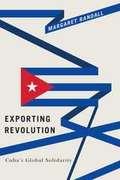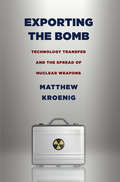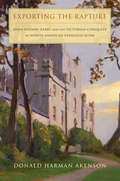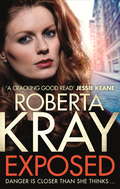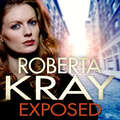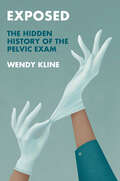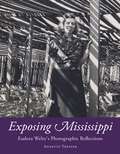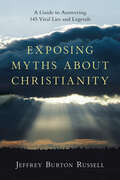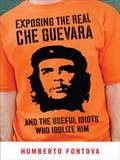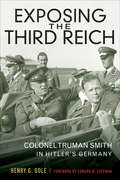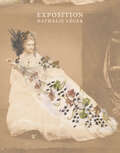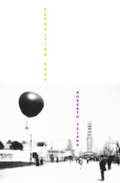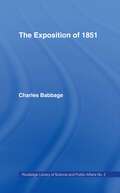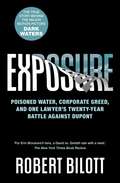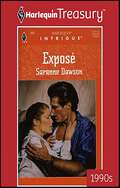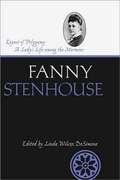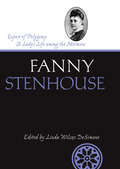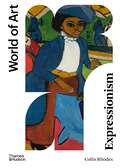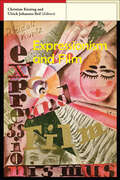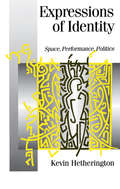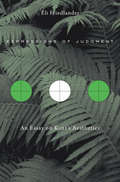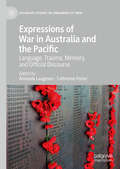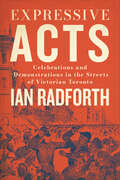- Table View
- List View
Exporting Revolution: Cuba's Global Solidarity
by Margaret RandallIn her new book, Exporting Revolution, Margaret Randall explores the Cuban Revolution's impact on the outside world, tracing Cuba's international outreach in health care, disaster relief, education, literature, art, liberation struggles, and sports. Randall combines personal observations and interviews with literary analysis and examinations of political trends in order to understand what compels a small, poor, and underdeveloped country to offer its resources and expertise. Why has the Cuban health care system trained thousands of foreign doctors, offered free services, and responded to health crises around the globe? What drives Cuba's international adult literacy programs? Why has Cuban poetry had an outsized influence in the Spanish-speaking world? This multifaceted internationalism, Randall finds, is not only one of the Revolution's most central features; it helped define Cuban society long before the Revolution.
Exporting the Bomb: Technology Transfer and the Spread of Nuclear Weapons
by Matthew KroenigIn a vitally important book for anyone interested in nuclear proliferation, defense strategy, or international security, Matthew Kroenig points out that nearly every country with a nuclear weapons arsenal received substantial help at some point from a more advanced nuclear state. Why do some countries help others to develop nuclear weapons? Many analysts assume that nuclear transfers are driven by economic considerations. States in dire economic need, they suggest, export sensitive nuclear materials and technology-and ignore the security risk-in a desperate search for hard currency.Kroenig challenges this conventional wisdom. He finds that state decisions to provide sensitive nuclear assistance are the result of a coherent, strategic logic. The spread of nuclear weapons threatens powerful states more than it threatens weak states, and these differential effects of nuclear proliferation encourage countries to provide sensitive nuclear assistance under certain strategic conditions. Countries are more likely to export sensitive nuclear materials and technology when it would have the effect of constraining an enemy and less likely to do so when it would threaten themselves.In Exporting the Bomb, Kroenig examines the most important historical cases, including France's nuclear assistance to Israel in the 1950s and 1960s; the Soviet Union's sensitive transfers to China from 1958 to 1960; China's nuclear aid to Pakistan in the 1980s; and Pakistan's recent technology transfers, with the help of "rogue" scientist A. Q. Khan, from 1987 to 2002. Understanding why states provide sensitive nuclear assistance not only adds to our knowledge of international politics but also aids in international efforts to control the spread of nuclear weapons.
Exporting the Rapture: John Nelson Darby and the Victorian Conquest of North American Evangelicalism
by Donald Harman AkensonApocalyptic millennialism is one of the most powerful strands in evangelical Christianity. Across many powerful evangelical groups there is general devotion to faith in the physical return of Jesus in the Second Coming, the affirmation of a Rapture heavenward of "saved" believers, a millennium of peace under the rule of Jesus and his saints, and, eventually, a final judgment and entry into deep eternity. In Discovering the End of Time Donald Akenson traced the emergence of modern apocalyptic millennialism to southern Ireland in the 1820s and '30s. In Exporting the Rapture he documents how the complex ideological construction that has come to dominate modern evangelical thought was enhulled in an organizational system that made it exportable from the British Isles to North America – and around the world. A key figure in this process was John Nelson Darby, a formative influence on evangelical apocalypticism in Ireland and the volatile central figure in Brethren apocalypticism throughout the British Isles, who ultimately became a successful missionary to the United States and Canada. Akenson emphasizes that, as strong a personality as John Nelson Darby was, the real story is that he became a vector for the transmission of a highly seductive ideological system from the old world to the new. So beguiling, adaptable, and compelling was the new Dispensational system that Darby injected into North American evangelicalism that it continued to spread widely after his death. By the 1920s, the system had become the doctrinal template of the fundamentalist branch of North-American evangelicalism. Highlighting the brilliant influence of John Nelson Darby, Exporting the Rapture documents for the first time how the complex construct of Dispensationalism was repackaged from its southern Irish roots into a system ideal for North American evangelicals.
Exposed: A gripping, gritty gangland thriller of murder, mystery and revenge
by Roberta KrayUncover the truth or end up six feet underNO ONE KNOWS CRIME LIKE KRAY'A cracking good read!' Jessie Keane'Martina Cole territory' Independent'Gripping' Daily ExpressCut from the same cloth as Kimberley Chambers, Martina Cole and Casey Kelleher. ***DECEIVED is available to pre-order now in hardback and ebook***Eden Chase is head over heels in love with her husband Tom. He's the sort of man who doesn't give much away but Eden doesn't mind that - Tom is worth the effort. So when he's accused of a years-old robbery and murder, Eden won't believe it. No, not her Tom - he's not capable of the things they're saying he did. With Tom in prison, it's up to Eden to clear his name. But the closer she gets to the truth, the more she uncovers about her husband's past. Does she really know him, after all? As Eden goes deeper into the ugly underworld that holds the answers, the more danger she's exposed to and she's not sure she can save her husband in time. And is he even worth saving?Praise for Roberta Kray:'A cracking good read' Jessie Keane 'Well into Martina Cole territory' Independent 'Action, intrigue and a character-driven plot . . . sure to please any crime fiction fans' Woman 'Gripping' Daily Express
Exposed: A gripping, gritty gangland thriller of murder, mystery and revenge
by Roberta KrayUncover the truth or end up six feet underNO ONE KNOWS CRIME LIKE KRAY'A cracking good read!' Jessie Keane'Martina Cole territory' Independent'Gripping' Daily ExpressCut from the same cloth as Kimberley Chambers, Martina Cole and Casey Kelleher. ***DECEIVED is available to pre-order now in hardback and ebook***Eden Chase is head over heels in love with her husband Tom. He's the sort of man who doesn't give much away but Eden doesn't mind that - Tom is worth the effort. So when he's accused of a years-old robbery and murder, Eden won't believe it. No, not her Tom - he's not capable of the things they're saying he did. With Tom in prison, it's up to Eden to clear his name. But the closer she gets to the truth, the more she uncovers about her husband's past. Does she really know him, after all? As Eden goes deeper into the ugly underworld that holds the answers, the more danger she's exposed to and she's not sure she can save her husband in time. And is he even worth saving?Praise for Roberta Kray:'A cracking good read' Jessie Keane 'Well into Martina Cole territory' Independent 'Action, intrigue and a character-driven plot . . . sure to please any crime fiction fans' Woman 'Gripping' Daily Express
Exposed: The Hidden History of the Pelvic Exam (History of Health and Illness)
by Wendy KlineThe pelvic exam. If you’ve ever had one, you’re probably already wincing. It might be considered a routine medical procedure, but for most of us, it is anything from unpleasant to traumatic. In Exposed, noted historian Wendy Kline uncovers the procedure’s fascinating—and often disturbing—history. From gynecological research on enslaved women’s bodies to nonconsensual practice on anesthetized patients, the pelvic exam as we know it today carries the burden of its sordid past. Its story is one of pain and pleasure, life-saving discoveries and heartbreaking encounters, questionable procedures and triumphant breakthroughs. Drawing on previously unpublished archival sources, along with interviews with patients, providers, and activists, Kline traces key moments and movements in gynecological history, from the surgeons of the nineteenth century to the OB/GYNs of today. This powerful book reminds us that the pelvic exam is has never been “just” a medical procedure, and that we can no longer afford to let the pelvic exam remain unexamined.
Exposing Mississippi: Eudora Welty's Photographic Reflections (Critical Perspectives on Eudora Welty)
by Annette TrefzerWINNER OF THE 2022 EUDORA WELTY PRIZEInternationally known as a writer, Eudora Welty has as well been spotlighted as a talented photographer. The prevalent idea remains that Welty simply took snapshots before she found her true calling as a renowned fiction writer. But who was Welty as a photographer? What did she see? How and why did she photograph? And what did Welty know about modern photography? In Exposing Mississippi: Eudora Welty's Photographic Reflections, Annette Trefzer elucidates Welty’s photographic vision and answers these questions by exploring her photographic archive and writings on photography. The photographs Welty took in the 1930s and ’40s frame her visual response to the cultural landscapes of the segregated South during the Depression. The photobook One Time, One Place, which was selected, curated, and shaped into a visual narrative by Welty herself, serves as a starting point and guide for the chapters on her spatial hermeneutic. The book is divided into sections by locations and offers how the framing of these areas reveals Welty’s radical commentary of the spaces her camera captured. There are over eighty images in Exposing Mississippi, including some never-before-seen archival photographs, and sections of the book draw on over three hundred more. The chapters on institutional, leisure, and memorial landscapes address how Welty’s photographs contribute to, reflect on, and intervene in customary visual constructions of the Depression-era South.
Exposing Myths About Christianity: A Guide to Answering 145 Viral Lies and Legends
by Jeffrey Burton RussellRenowned historian, Jeffrey Burton Russell, famous for his studies of medieval history, turns to the serious questions that confront Christianity in contemporary culture. Russell examines a wide array of common mispercerptions, characterizations, stereotypes, caricatures and outright myths about Christianity that circulate heavily within today?s society, and are even believed by many Christians. In a succinct and engaging manner, Russell discusses these errors and provides thoughtful, even-handed, carefully researched and sharp-witted responses. The author sets the record straight against the New Atheists and other cultural critics who charge Christianity with being outdated, destructive, superstitious, unenlightened, racist, colonialist, based on fabrication, and other significant false accusations.
Exposing the Real Che Guevara: And the Useful Idiots Who Idolize Him
by Humberto FontovaThe perfect conservative contrast to the upcoming movie about Che. Hollywood, Madison Avenue, and the mainstream media celebrate Ernesto ?Che? Guevara as a saint, a sex symbol, and a selfless martyr. But their ideas about Che ? whose face adorns countless T-shirts and posters ? are based on the lies of Fidel Castro?s murderous dictatorship. Che?s hipster fans are classic ?useful idiots,? the name Stalin gave to foolish Westerners who parroted his lies about communism. And their numbers will only increase after a new biopic is released this fall, starring Benicio Del Toro. But as Humberto Fontova reveals in this myth-shattering book, Che was actually a bloodthirsty executioner, a military bumbler, a coward, and a hypocrite. In fact, Che can be called the godfather of modern terrorism. Fontova reveals: ? How he longed to destroy New York City with nuclear missiles. ? How he persecuted gays, blacks, and religious people. ? How he loved material wealth and private luxuries, despite his image as an ascetic. Are Che fans like Angelina Jolie, Jesse Jackson, Carlos Santana, and Johnny Depp too ignorant to realize they?ve been duped? Or too anti-American to care? .
Exposing the Third Reich: Colonel Truman Smith in Hitler's Germany (American Warriors Series)
by Henry G. Gole&“A fascinating book about a virtually unknown officer who played a major role in the development of US military planning before and during World War II&” (Bowling Green Daily News). A vital source of American intelligence on Hitler&’s rise to power and military ambitions, Colonel Truman Smith was one of the most compelling and controversial figures of the Second World War. In Exposing the Third Reich, Henry G. Gole tells this soldier's story for the first time. An American aristocrat from a prominent New England family, Smith became an expert on Germany when he was first assigned there during the Allied occupation of 1919. As a military attaché in 1935, he arranged for his good friend Charles Lindbergh to inspect the Luftwaffe. The Germans were starstruck by the famous aviator, enabling Smith to gather key intelligence about their air capability. His deep access and knowledge made him invaluable to General George C. Marshall; however, the colonel's friendliness with Germany also aroused suspicion that he was a Nazi sympathizer. Gole demonstrates that, far from condoning Hitler, Smith was among the first to raise the alarm: he predicted many of the Nazis' moves years in advance and feared that the international community would not act quickly enough. Featuring many firsthand observations of the critical changes in Germany between the world wars, this biography presents an indispensable look both at a fascinating figure and at the nuances of the interwar years.
Exposition
by Nathalie LégerThe first in Nathalie Léger&’s acclaimed genre-defying triptych of books about the struggles and obsessions of women artists. Exposition is the first in a triptych of books by the award-winning writer and archivist Nathalie Léger that includes Suite for Barbara Loden and The White Dress. In each, Léger sets the story of a female artist against the background of her own life and research—an archivist's journey into the self, into the lives that history hides from us. Here, Léger's subject is the Countess of Castiglione (1837–1899), who at the dawn of photography dedicated herself to becoming the most photographed woman in the world, modeling for hundreds of photos, including &“Scherzo di Follia,&” among the most famous in history. Set long before our own &“selfie&” age, Exposition is a remarkably modern investigation into the curses of beauty, fame, vanity, and age, as well as the obsessive drive to control and commodify one's image.
Exposition Park (The Driftless Series)
by Roberto TejadaImagine a walking tour of stanzas and prose poems that give lyric voice to sight, public speech, and spectacle. In Exhibition Park, Roberto Tejada delivers a command performance in mixed genres that compel an array of literary styles. His poetry undertakes a wide range of subjects motivated by artworks from Latin America and the United States covering the colonial period to the present day. In serial poems, short sketches, guidebook parodies, painterly triptychs, translations, and other word-based dioramas, Tejada coins wonder with historical styles--baroque, classic, and experimental. As likened to a world's fair, the resulting voices intone global stories, the dream life of art, and first-person atmospheres both premodern and postindustrial. "Tejada's work is with dismantling borders and upsetting classifications... The result is a layered poetry that finds its form in dense stanzas composed of lines that frequently veer toward a kind of fractured prose..."--Alan Gilbert in Another Future: Poetry and Modern Art in a Postmodern Twilight"You walk through his world as a voyeur, a traveler of mirrors, witnessing your own reflection in the masses of flesh, simultaneously aroused and disturbed at the same time. Tejada's work is an invitation, a window into another world, unabashedly erotic, and succinct."--Christine Lark Fox, Poetry Project Newsletter, about Mirrors for Gold
Exposition of 1851: Or Views of the Industry, The Science and the Government of England (Cambridge Library Collection - British And Irish History, 19th Century Ser.)
by Charles BabbagePart of the library of Science and Public Affairs and originally published in 1851, this study relates views of the industry, science and the Government of England in 1851.
Exposure: Poisoned Water, Corporate Greed, And One Lawyer's Twenty-year Battle Against Dupont
by Robert BilottERIN BROCKOVICH meets SILENT SPRING in this astounding true story of a lawyer who spent two decades building a case against one of the world’s largest chemical companies, uncovering a shocking history of environmental pollution and heartless cover-up. The story that inspired the forthcoming motion picture from Participant Media/Focus Features, starring Mark Ruffalo, Anne Hathaway, Bill Pullman and Tim Robbins, directed by Todd Haynes. In 1998, Robert Bilott was a 33-year-old Cincinnati lawyer on the verge of making partner when his career and life took an unforeseen turn. He was taken by surprise when he received a call from a man named Earl Tennant, a farmer from West Virginia with a slight connection to Robert’s family. Earl was convinced the creek on his property, where his cattle grazed, was being poisoned by run-off from a neighbouring factory landfill. His cattle were dying in hideous ways, and he hadn’t even been able to get a water sample tested by local agencies, politicians or vets. As soon as they heard the name DuPont – the area’s largest employer – he felt they were reluctant to investigate further. Once Robert saw the thick, foamy water that bubbled into the creek, the gruesome effects it seemed to have on livestock, and the disturbing frequency of cancer and lung problems in the surrounding area, he was persuaded to fight against the type of corporation his firm routinely represented. With all the cards stacked against him, Rob happened upon a stray reference in a random memo to a chemical called PFOA – a substance he’d never heard of that is used in the manufacture of Teflon. From that one reference, he ultimately gained access to 110,000 pages of DuPont documents, some of them fifty years old, that reveal decades of medical studiesproving the harmful – more often than not fatal – effects of PFOA in animals and humans. And yet PFOA sludge had still been dumped into rivers and landfill, endangering many lives. The case of one farmer soon spawns a class-action suit and the shocking realisation that virtually every person on the planet has been exposed to PFOA and carries the chemical in his or her blood.This is the unforgettable story of the lawyer who worked tirelessly for twenty years to get justice for all those who had suffered because of this chemical.
Exposé
by Saranne DawsonIN-DEPTH, EXCLUSIVE AND VERY INTIMATEHe was daring, dangerous, devious-and her ex-husband!Like a flash, wonderboy reporter Sam Winters stormed back into Kate Stevens's life-and under the conjugal roof. But Kate was on to the biggest story of her career, tracking a cunning lobbyist and a corrupt politician-one of whom wanted her dead.Sam claimed he was dead set on protecting her, but Kate knew he would do anything for a story, including steal it from her. Could his open arms and deep blue eyes be telling the truth this time?As the pieces of her story fit together, Kate didn't know whether her biggest power play of all would be with sexy Sam or the Washington honchos. Only one of them could be trusted.
Exposé of Polygamy
by Linda Wilcox Desimone Fanny StenhouseAfter the 1872 publication of Exposé, Fanny Stenhouse became a celebrity in the cultural wars between Mormons and much of America. An English convert, she had grown disillusioned with the Mormon Church and polygamy, which her husband practiced before associating with a circle of dissident Utah intellectuals and merchants. Stenhouse's critique of plural marriage, Brigham Young, and Mormonism was also a sympathetic look at Utah's people and honest recounting of her life. She later created a new edition, titled "Tell It All," which ensured her notoriety in Utah and popularity elsewhere but turned her thoughtful memoir into a more polemical, true exposé of Polygamy. Since 1874, it has stayed in print, in multiple, varying editions. The original book, meanwhile, is less known, though more readable. Tracing the literary history of Stenhouse's important piece of Americana, Linda DeSimone rescues an important autobiographical and historical record from the baggage notoriety brought to it.
Exposé of Polygamy: A Lady's Life Among the Mormons (Life Writings Frontier Women #1)
by Fanny StenhouseAfter the 1872 publication of Expose',Fanny Stenhouse became a celebrity in the cultural wars between Mormons and much of America. An English convert, she had grown disillusioned with the Mormon Church and polygamy, which her husband practiced before associating with a circle of dissident Utah intellectuals and merchants. Stenhouse’s critique of plural marriage, Brigham Young, and Mormonism was also a sympathetic look at Utah’s people and honest recounting of her life. Before long, she created a new edition, titled "Tell It All," which ensured her notoriety in Utah and popularity elsewhere but turned her thoughtful memoir into a more polemical, true expose' of Polygamy. Since 1874, it has stayed in print, in multiple, varying editions. The original book, meanwhile, is less known, though more readable. Tracing the literary history of Stenhouse’s important piece of Americana, Linda DeSimone rescues an important autobiographical and historical record from the baggage notoriety brought to it.
Expressionism
by Mary Whittall Wolf-Dieter DubeThe story of this decisive and immensely rich contribution to the history of twentieth-century art is told here by a senior curator of the Bavarian State Art Collection, largely in the vivid and intensely revealing words of the artists themselves.
Expressionism (World of Art)
by Colin RhodesA new comprehensive overview of expressionism, tracing its evolution from the nineteenth century to the present day. Expressionist artists believed in art's ability to communicate emotion, irrespective of any representational or narrative content. In this comprehensive introduction to one of the most radical artistic movements of our time, writer, artist, curator, and educator Colin Rhodes traces the thread of expressionist thought from the nineteenth century to the present day, mapping its various manifestations across Europe and the US, as well as parts of Africa, Asia, and South America. By paying particular attention to nuanced issues of gender, sexuality, and cultural appropriation, Rhodes challenges the received art-historical narrative and reassesses it in the context of broader twentieth- and twenty-first-century artistic practice. Generously illustrated, the diverse selection of artists featured in this book range from Wassily Kandinsky, Erma Bossi, Francis Bacon, and Mark Rothko to Ursula Schultze-Bluhm, Gillian Ayres, Purvis Young, and Jadé Fadojutimi.
Expressionism and Film
by Rudolf KurtzExpressionism and Film, originally published in German in 1926, is not only a classic of film history, but also an important work from the early phase of modern media history. Written with analytical brilliance and historical vision by a well-known contemporary of the expressionist movement, it captures Expressionism at the time of its impending conclusion—as an intersection of world view, resoluteness of form, and medial transition. Though one of the most frequently-cited works of Weimar culture, Kurtz's groundbreaking work, which is on a par with Siegfried Kracauer's From Caligari to Hitler and Lotte Eisner's The Haunted Screen, has never been published in English. Its relevance and historical contexts are analyzed in a concise afterword by the Swiss scholars Christian Kiening and Ulrich Johannes Beil.
Expressions of Identity: Space, Performance, Politics (Published in association with Theory, Culture & Society)
by Kevin HetheringtonThis innovative book sets out to question what we understand by the term `new social movements'. By examining a range of issues associated with identity politics and alternative lifestyles, the author challenges those who treat new social movements as instances of wider social change while often ignoring their more `local' and `dispersed' importance. This book questions what it means to adopt an identity that is organised around issues of expressivism - and offers a series of non-reductionist ways of looking at identity politics. Hetherington analyzes expressive identities through issues of performance, spaces of identity and `the occasion'. This important work shows how the significance of identity politics are at once local, plural, situated and topologically complex.
Expressions of Judgment: An Essay on Kant's Aesthetics
by Eli FriedlanderKant's The Critique of Judgment laid the groundwork of modern aesthetics when it appeared in 1790. Eli Friedlander's reappraisal emphasizes the internal connection of judgment and meaning, showing how the pleasure in judging is intimately related to our capacity to draw meaning from our encounter with beauty.
Expressions of Judgment: An Essay on Kant's Aesthetics
by Eli FriedlanderThe Critique of Judgment-the third and final work in Kant's critical system-laid the groundwork of modern aesthetics when it appeared in 1790. Eli Friedlander's reappraisal of this seminal accomplishment reformulates and elucidates Kant's thought in order to reveal the inner unity of the Third Critique. Expressions of Judgment emphasizes the internal connection of judgment and meaning in Kant's aesthetics, showing how the pleasure in judging is intimately related to our capacity to draw meaning from our encounter with beauty. Although the meaningfulness of aesthetic judgment is most evident in the response to art, the appreciation of nature's beauty has an equal share in the significant experience of our world. Friedlander's attention to fundamental dualities underlying the Third Critique-such as that of art and nature-underscores how its themes are subordinated systematically to the central task Kant sets himself: that of devising a philosophical blueprint for the mediation between the realms of nature and freedom. This understanding of the mediating function of judgment guides Friedlander in articulating the dimensions of the field of the aesthetic that opens between art and nature, the subject and the object, knowledge and the will, as well as between the individual and the communal. Expressions of Judgment illuminates the distinctness as well as the continuity of this important late phase in Kant's critical enterprise, providing insights for experienced scholars as well as new students of philosophy.
Expressions of War in Australia and the Pacific: Language, Trauma, Memory, and Official Discourse (Palgrave Studies in Languages at War)
by Catherine Fisher Amanda LaugesenThis edited book includes chapters that explore the impact of war and its aftermath in language and official discourse. It covers a broad chronological range from the First World War to very recent experiences of war, with a focus on Australia and the Pacific region. It examines three main themes in relation to language: the impact of war and trauma on language, the language of war remembrance, and the language of official communications of war and the military. An innovative work that takes an interdisciplinary approach to the themes of war and language, the collection will be of interest to students and scholars across linguistics, literary studies, history and conflict studies.
Expressive Acts: Celebrations and Demonstrations in the Streets of Victorian Toronto
by Ian RadforthIn nineteenth-century Toronto, people took to the streets to express their jubilation on special occasions, such as the 1860 visit of the Prince of Wales and the return in 1885 of the local Volunteers who helped to suppress the Riel resistance in the North-West. In a contrasting mood, people also took to the streets in anger to object to government measures, such as the Rebellion Losses bill, to heckle rival candidates in provincial election campaigns, to assert their ethno-religious differences, and to support striking workers. Expressive Acts examines instances of both celebration and protest when Torontonians publicly displayed their allegiances, politics, and values. The book illustrates not just the Victorian city’s vibrant public life but also the intense social tensions and cultural differences within the city. Drawing from journalists’ accounts in newspapers, Expressive Acts illuminates what drove Torontonians to claim public space, where their passions lay, and how they gave expression to them.
